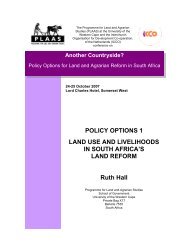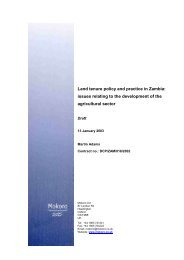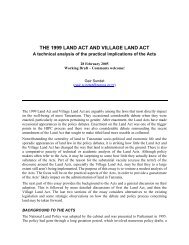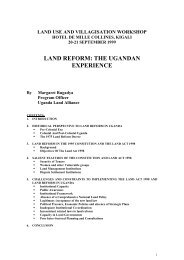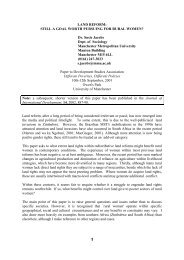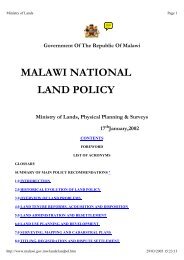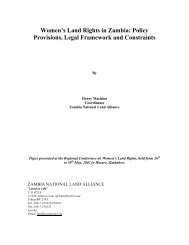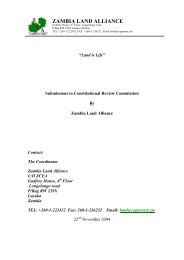Gender Issues and Best Practices in Land Administration ... - Mokoro
Gender Issues and Best Practices in Land Administration ... - Mokoro
Gender Issues and Best Practices in Land Administration ... - Mokoro
Create successful ePaper yourself
Turn your PDF publications into a flip-book with our unique Google optimized e-Paper software.
TITLE: Guide to <strong>Gender</strong> <strong>Issues</strong> <strong>and</strong> <strong>Best</strong> <strong>Practices</strong> <strong>in</strong> L<strong>and</strong> Adm<strong>in</strong>istration ProjectsIs the director of the l<strong>and</strong> agency held responsible for nondiscrim<strong>in</strong>atory practices withregard to gender?What documents are required by the regulations for proof of ownership? Are thesedocuments readily available to both men <strong>and</strong> women, <strong>and</strong> are they expensive to acquire?Do the regulations require proof of marriage or consensual union? What type of proof isrequired?Do the regulations require written consent for transfer of property held <strong>in</strong> commonownership? Are there guidel<strong>in</strong>es for how to determ<strong>in</strong>e whether l<strong>and</strong> is held <strong>in</strong> commonownership by operation of law, even if it is registered <strong>in</strong> only one name?Do the regulations deal with polygamy if necessary?Do the regulations deal with illiteracy?Where are disputes adjudicated?How do the issues of money, time <strong>and</strong> literacy <strong>in</strong>fluence the dispute resolution process?(p.26)7. AdjudicationOn adjudication, these are some of the questions that need to be considered to protect the<strong>in</strong>terests of women <strong>and</strong> men:1. Have all of the stakeholders had access to <strong>in</strong>formation concern<strong>in</strong>g their rights <strong>and</strong> theadjudication process?2. Is the adjudication team familiar with the local customs, laws, <strong>and</strong> practices affect<strong>in</strong>g therights of both men <strong>and</strong> women?3. Do the processes have to be modified from region to region (for example, urban/rural orother types of l<strong>and</strong> tenure?4. Are secondary <strong>in</strong>terests, <strong>in</strong>clud<strong>in</strong>g rights to resources, considered <strong>and</strong> protected <strong>in</strong> someway through the adjudication?5. Do all stakeholders have equal access to the documentation required for adjudication,<strong>and</strong>, if not, what measures can be taken to level the play<strong>in</strong>g field?6. Are the tim<strong>in</strong>g <strong>and</strong> location of adjudication procedures <strong>and</strong> registration officesappropriate for all potential <strong>in</strong>terest holders.7. Are women’s rights adequately represented <strong>and</strong> protected <strong>in</strong> dispute resolution <strong>and</strong> howcan lengthy <strong>and</strong> costly litigation be avoided? (pp.34-35).8. Know<strong>in</strong>g your rights, education <strong>and</strong> tra<strong>in</strong><strong>in</strong>gThe report makes the valid po<strong>in</strong>t that ‘legislative reform by itself often makes little differenceto the majority of women’ <strong>and</strong> that those who take advantage tend to be ‘urban, educated,<strong>and</strong> usually wealthy women.’ (p.25). But law can create open<strong>in</strong>gs for women’s l<strong>and</strong> rights.Hence the trend is to avoid hav<strong>in</strong>g disputes reach the courts, partly because of cost <strong>and</strong>partly because ‘disputants, particularly women, often have unequal powers to acquire legaladvice <strong>and</strong> to susta<strong>in</strong> their claims.’ (p.34)‘The most important aspect of the provision of public notice is that all potentialstakeholders have the ability to know about <strong>and</strong> underst<strong>and</strong> their rights <strong>and</strong> anythreat to those rights. Thus, issues such as media, illiteracy (<strong>in</strong>clud<strong>in</strong>g map illiteracy),location, <strong>and</strong> tim<strong>in</strong>g are crucial. Public displays need to be accessible to everyone, <strong>in</strong>clud<strong>in</strong>gthe elderly <strong>and</strong> those who cannot leave home because of cost, lack of transportation, orhousehold responsibilities. Whereas this affects both women <strong>and</strong> men, women <strong>in</strong> rural areasare often less mobile than men.’ (p.33)Author/Dept: palmerCreated: 10-Mar-12. Last saved: 14/03/2012 13:10:00 Page 6 of 7D:\Documents\WEBSITE\Net\Africa general docs\wb_guide_gender_best_practices_l<strong>and</strong>_adm<strong>in</strong>.rtf





